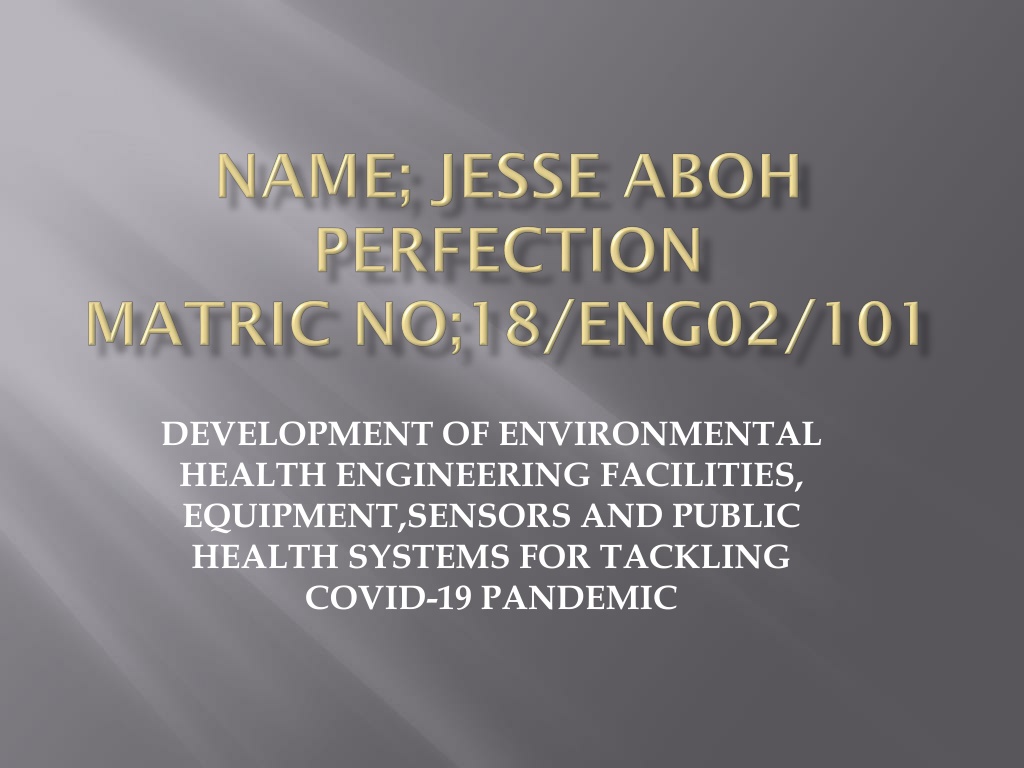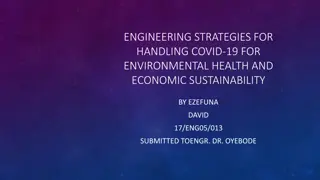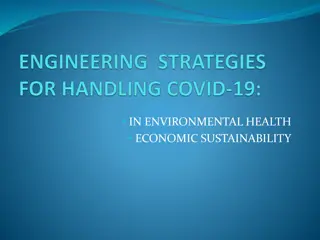Development of Environmental Health Engineering Facilities for Tackling COVID-19 Pandemic
Coronavirus disease (COVID-19) overview, prevention, symptoms, and the importance of environmental health engineering facilities, equipment, sensors, and public health systems in combatting the pandemic. Emphasizes prevention measures, lack of a vaccine, and the role of computer engineering in Nigeria.
Download Presentation

Please find below an Image/Link to download the presentation.
The content on the website is provided AS IS for your information and personal use only. It may not be sold, licensed, or shared on other websites without obtaining consent from the author. Download presentation by click this link. If you encounter any issues during the download, it is possible that the publisher has removed the file from their server.
E N D
Presentation Transcript
DEVELOPMENT OF ENVIRONMENTAL HEALTH ENGINEERING FACILITIES, EQUIPMENT,SENSORS AND PUBLIC HEALTH SYSTEMS FOR TACKLING COVID-19 PANDEMIC
Coronavirus Overview Prevention Symptoms Coronavirus disease (COVID-19) is an infectious disease caused by a newly discovered coronavirus. Most people infected with the COVID-19 virus will experience mild to moderate respiratory illness and recover without requiring special treatment. Older people, and those with underlying medical problems like cardiovascular disease, diabetes, chronic respiratory disease, and cancer are more likely to develop serious illness. The best way to prevent and slow down transmission is be well informed about the COVID-19 virus, the disease it causes and how it spreads. Protect yourself and others from infection by washing your hands or using an alcohol based rub frequently and not touching your face. The COVID-19 virus spreads primarily through droplets of saliva or discharge from the nose when an infected person coughs or sneezes, so it s important that you also practice respiratory etiquette (for example, by coughing into a flexed elbow). At this time, there are no specific vaccines or treatments for COVID-19. However, there are many ongoing clinical trials evaluating potential treatments. WHO will continue to provide updated information as soon as clinical findings become available.
Theres currently no vaccine to prevent coronavirus disease (COVID-19). You can protect yourself and help prevent spreading the virus to others if you: Do Wash your hands regularly for 20 seconds, with soap and water or alcohol-based hand rub Cover your nose and mouth with a disposable tissue or flexed elbow when you cough or sneeze Avoid close contact (1 meter or 3 feet) with people who are unwell Stay home and self-isolate from others in the household if you feel unwell Don't Touch your eyes, nose, or mouth if your hands are not clean
Computer engineering is a discipline that blends Computer science with Electrical engineering. Being a dynamic profession, it harmonizes technology and innovation to develop computer hardware and software. ... With such prospects, computer engineering in Nigeria becomes a gravy train; a hotcake! Background Engineering requires many building blocks and tools. To produce real world results, one must practically apply mathematics and sciences to tangible problems and scenarios. Included in this category are the various technical topics which cut across engineering disciplines, encompassing many branches of mathematics and scientific disciplines.
Computer-Aided Software Engineering (CASE) software or "facilities" assist computer programmers or system developers in the design, development and testing of a computer program. Traditionally, the steps necessary to implement a computer program were peComputer-aided software engineering (CASE) is the domain of software tools used to design and implement applications. ... CASE software is often associated with methods for the development of information systems together with automated tools that can be used in the software development processrformed manually.
Some of the positive effects are faster communication, an organization of data and information, computerization of tasks, and easier access to the information. Some of the negative effects of computers are human's break their social interact with friends and families, cause back problem, depression, and poor health. HOW COMPUTER ENGINEERING HAS CHANGED THE WORLD Computers have changed the world in many ways. They allow huge amounts of information to be stored in a small space. They also allow a person to calculate mathematical problems with ease. Finally, computers allow people to communicate with one another through internet sites such as FaThey have made human lives better and happier. There are many computer uses in different fields of work. Engineers, architects, jewelers, and filmmakers all use computers to design things. Teachers, writers, and most office workers use computers for research, word processing and emailingcebook, My Space, and Twitter.
You can help fight the coronavirus. All you need is a computer Donating computing time can help create a virtual supercomputer that can search for a cure coronavirus computer illustration The Folding@home virtual supercomputer, which draws on the computing power of many home computers, is searching for ways to attack the novel coronavirus with new drugs. PHOTO: METAMORWORKS/ISTOCK/GETTY IMAGES PLUS; VIRUS: FILO/DIGITALVISION VECTORS/GETTY IMAGES Share this: Facebook Twitter Pocket Reddit Print By Maria Temming MARCH 25, 2020 AT 6:00 AM UPDATED MARCH 26, 2020 AT 1:30 PM Staying home isn t the only way to help fight the coronavirus pandemic. Hundreds of thousands of volunteers have added their home computers to a vast network that forms a virtual supercomputer called Folding@home. The Folding@home project, which uses crowdsourced computing power to run simulations of proteins for researchers studying diseases, announced in February that it would begin analyzing proteins found in the coronavirus behind the ongoing pandemic (SN: 3/4/20). These proteins are tools that help the virus infect human cells. Using computer simulations, researchers are mapping the coronavirus s proteins, in hopes of revealing vulnerabilities that can be attacked with new drugs. The more volunteers who donate their unused computing power to the effort, the faster the virtual supercomputer can work its magic. Since the project announced its new focus on the coronavirus, around 400,000 new volunteers had joined, as of March 19. By March 26, that number had swelled to around 700,000. The collective computing power of that legion of volunteers makes Folding@home by far the most powerful supercomputer in the world. Science News spoke with project leader Gregory Bowman, a biophysicist at Washington University School of Medicine in St. Louis, about how the project works and how people can help.
How do simulations help map coronavirus proteins? Researchers have taken snapshots of the proteins of the coronavirus, called SARS-CoV-2, using techniques like X-ray crystallography and cryo-electron microscopy (SN: 10/4/17). But proteins don t hold still, Bowman says. All the atoms in the protein and [its surroundings] are continually pushing and pulling on each other, he says. What we re doing is modeling those physical interactions in the computer. Those simulations reveal the different shapes a protein s structure can take. What kinds of vulnerabilities are you looking for? You want a nice pocket on the surface of a protein where you can imagine this little molecule that we design inserting into a groove, Bowman says. But many proteins, particularly those in viruses, have seemingly smooth surfaces, making them hard to target. Folding@home simulations give scientists a chance to uncover what Bowman calls cryptic pockets potential docking sites for drugs that aren t visible in still images of the protein, but are revealed as the protein wriggles around in a computer simulation.



























